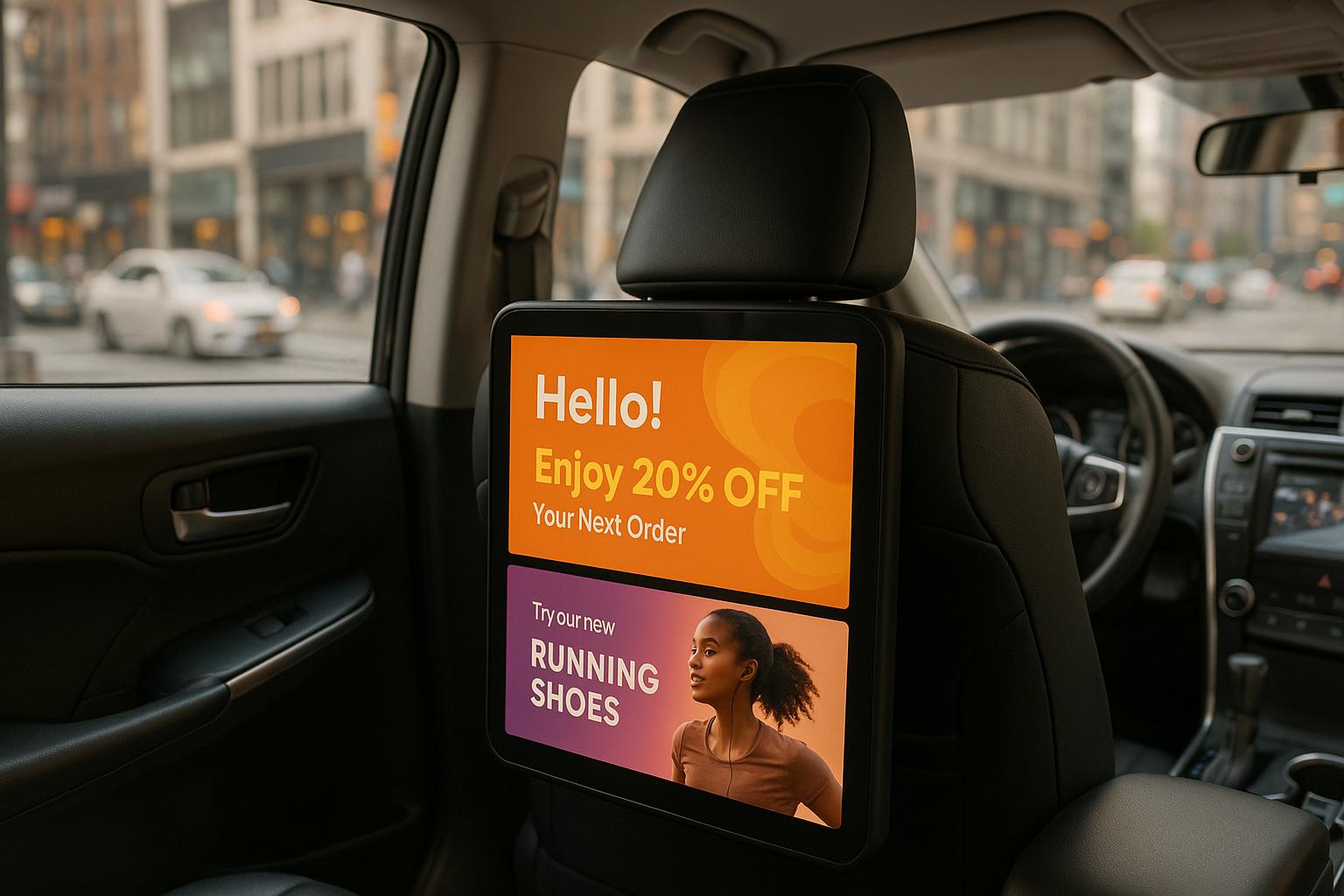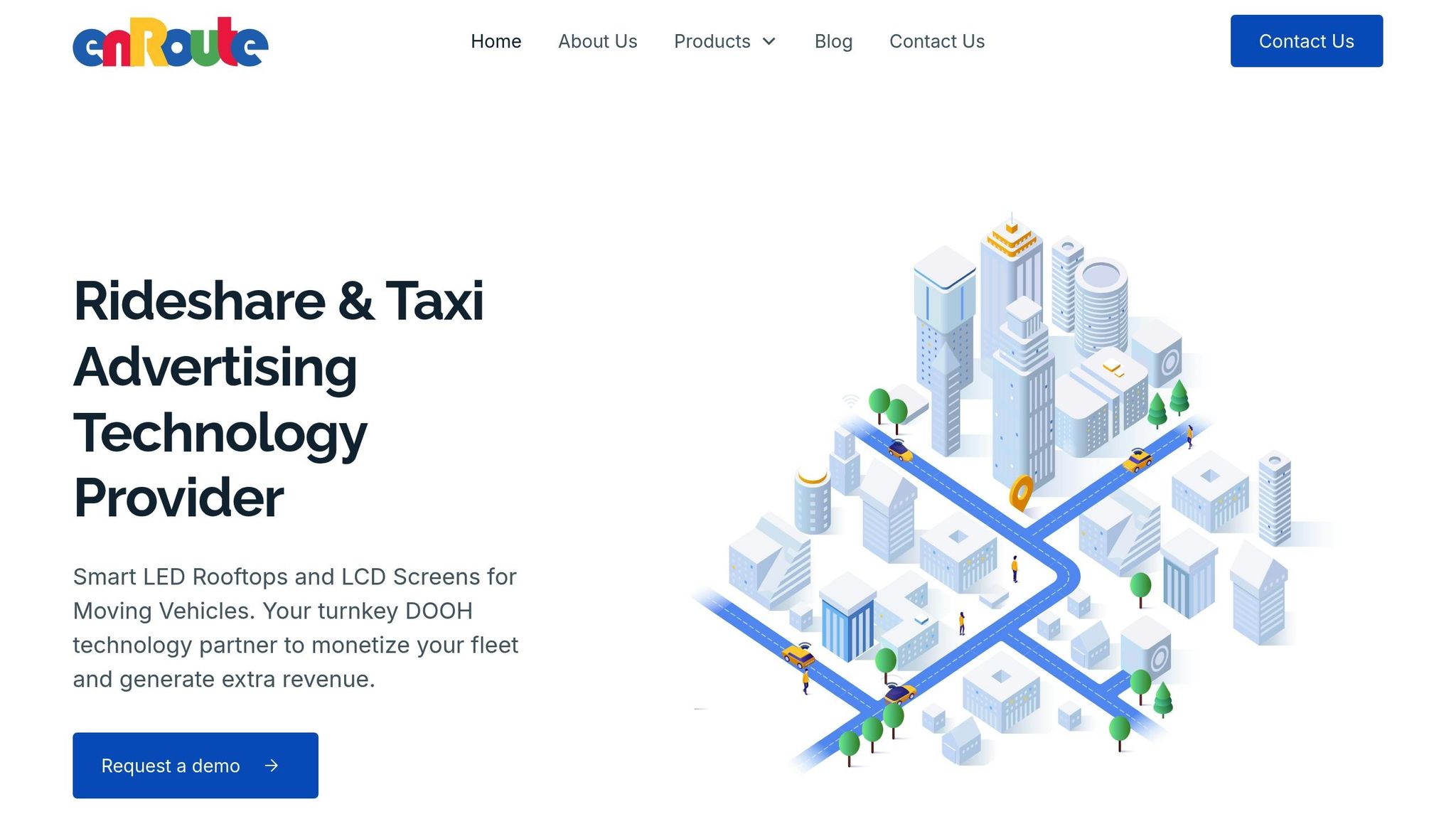Explore how AI is revolutionizing taxi advertising through personalized, real-time content that engages passengers and boosts brand relevance.

AI is transforming taxi advertising into a dynamic and personalized experience. By using real-time data like location, weather, and passenger behavior, AI-powered Digital Out-of-Home (DOOH) systems display ads tailored to specific audiences and contexts. Here’s how it works:
This approach benefits advertisers, fleet operators, and passengers alike by increasing engagement and revenue while making ads more relevant and timely. Companies like Enroute View Media are leading this shift with platforms that integrate advanced AI tools, offering new opportunities for targeted advertising in taxis.

Modern taxi advertising uses cutting-edge AI technologies to process massive amounts of data in milliseconds, ensuring ads are perfectly tailored to the audience and environment.
Machine learning algorithms work nonstop to analyze location data, traffic patterns, and surrounding conditions. This isn’t just about where a taxi is right now - it’s about where it’s been, where it’s going, and what’s happening nearby.
For instance, GPS data is processed with precision. A taxi cruising through Manhattan’s Financial District during the morning rush hour might show coffee ads, while the same route late at night could feature promotions for restaurants or nightlife.
Weather data also plays a role. Imagine a taxi navigating Chicago during a snowstorm - ads for winter gear or cozy indoor activities might pop up. On sunny days, the same vehicle could display promotions for outdoor dining or recreational events.
Traffic patterns are another key factor. AI systems understand that taxis stuck in gridlock offer longer exposure, making them perfect for detailed ads. In contrast, taxis zipping through light traffic benefit from simple, bold visuals that can grab attention quickly.
All of this real-time data flows into programmatic platforms, enabling instant ad selection and placement.
Once the data is analyzed, programmatic systems step in to turn insights into targeted ad placements.
Real-time bidding (RTB) platforms allow advertisers to bid on ad slots in mere seconds. These platforms consider factors like passenger demographics (based on pickup and drop-off points), current conditions, and campaign goals to determine the best ad match.
The process is lightning-fast. When a taxi enters a new area, the system broadcasts available ad space to advertisers. Their algorithms evaluate the opportunity and submit bids based on audience targeting and budget.
Dynamic pricing models adjust ad costs in real time, factoring in demand, location, and timing. Meanwhile, audience segmentation algorithms refine profiles by analyzing ride patterns. For example, a taxi frequently picking up passengers from luxury neighborhoods and dropping them at designer stores signals a very different audience than one catering to airport travelers or nightlife hotspots.
AI-powered cloud platforms provide the backbone for managing taxi ad campaigns across entire fleets. These distributed computing systems process data from thousands of vehicles, delivering personalized ad decisions to individual screens.
To reduce delays, edge computing handles some processing locally while staying connected to the cloud. This ensures ads continue displaying even if the connection briefly drops, while still benefiting from cloud-based intelligence for broader optimizations.
Campaign management tools track ad performance across fleets, identifying what works and scaling successful strategies. Over time, the AI learns which creative elements perform better in specific scenarios, improving campaign results.
API integrations connect taxi advertising systems to larger advertising ecosystems, allowing advertisers to manage campaigns across multiple platforms. For example, a brand could coordinate taxi ads with digital display or social media campaigns, ensuring consistent messaging across all channels.
By syncing data across platforms, advertisers can create cohesive experiences. A customer might see a taxi ad that aligns perfectly with a mobile ad they viewed earlier, reinforcing the message and driving engagement.
Together, these AI technologies bring a new level of personalization and responsiveness to taxi DOOH campaigns, making them more effective than ever before.
AI is reshaping how taxi advertising engages with passengers by delivering tailored content that aligns with individual preferences and real-time circumstances. These strategies go far beyond simple location-based targeting, offering deeply personalized experiences.
Taxi systems combine GPS data, weather conditions, and passenger trends to craft ads that feel relevant and timely. For instance, GPS coordinates help identify lifestyle patterns.
Location data allows advertisers to fine-tune their messaging. Upscale neighborhoods may see ads for luxury brands, while areas near campuses might feature student discounts. Time-based insights add another layer, distinguishing between early-morning commuters and late-night travelers, each requiring distinct messaging.
The system also tracks patterns among repeat passengers by analyzing pickup and drop-off locations. For instance, someone frequently traveling to an airport may be a business traveler, making them a prime audience for ads promoting hotels, car rentals, or professional services. Similarly, regular trips to medical facilities might trigger ads for health services, pharmacies, or wellness products.
Weather and local events further refine ad content. A rainy day might prompt ads for umbrellas or cozy cafes, while a sunny day could highlight outdoor activities. These data-driven insights lay the groundwork for creative, real-time adjustments, as explored next.
AI doesn’t just select ads - it fine-tunes them in real time for greater impact. This involves making adjustments within the same ad creative, rather than swapping out entire ads.
Take temperature-based content, for example. A restaurant chain might advertise hot soup and warm drinks when the temperature dips below 45°F but switch to cold beverages and ice cream when it climbs above 75°F. The overall brand message stays consistent, but the offerings adapt to the current weather.
Speed-sensitive adjustments are another example. When taxis are stuck in traffic, the system displays detailed ads featuring multiple product options, pricing, and longer videos. In contrast, during free-flowing traffic, the same campaign opts for bold visuals and minimal text that can be quickly absorbed.
Local events also play a role in creating context-specific ads. For instance, during major sports events, taxis near the venue might display team-themed content or game-day promotions. Concerts could prompt music-related ads, while conventions might trigger ads for business services.
The system continuously runs A/B tests on creative elements like headlines, images, colors, and call-to-action buttons. These tests help identify the most effective combinations for various scenarios, feeding the results back into the optimization engine to improve future performance.
This real-time creative optimization works hand-in-hand with strategic targeting, which we’ll now compare.
Different personalization strategies offer unique benefits and limitations, making it essential for advertisers to align their approach with campaign goals and available data.
| Strategy | Benefits | Limitations | Best Use Cases |
|---|---|---|---|
| Real-Time Geo-Targeting | Targets passengers based on immediate location and foot traffic | Requires highly accurate GPS data | Local businesses, event promotions, weather-sensitive products |
| Demographic-Based Ads | Tailored to audience profiles like age or income | Limited by data privacy and availability | Luxury goods, age-specific products, lifestyle services |
| Time-Based Personalization | Matches content to predictable daily routines | May overlook exceptions to routines | Food services, commuter products, entertainment venues |
| Weather-Responsive Content | Aligns with current conditions for added relevance | Only applicable to weather-dependent products | Retail, food delivery, seasonal services |
| Event-Driven Targeting | Leverages high-engagement moments like concerts or sports games | Requires seamless event data integration | Entertainment, hospitality, transportation services |
Among these, behavioral pattern recognition stands out as the most sophisticated approach. By analyzing ride frequency, destination types, timing, and seasonal trends, this strategy creates detailed passenger profiles. These profiles enable highly targeted ads that predict preferences with impressive accuracy.
Combining multiple strategies often yields the best results, enhancing both relevance and conversion rates. Success metrics vary depending on the approach. For example, geo-targeted campaigns often measure foot traffic and location-based conversions, while demographic-based ads focus on engagement rates and brand recall. Weather-responsive strategies evaluate the relationship between conditions and purchase behavior, offering clear insights into ROI and opportunities for further refinement.
Recent case studies highlight the practical advantages of combining AI technologies with personalization strategies. For example, research reveals that AI-powered taxi advertising significantly increases both engagement and brand recall by delivering content tailored to the specific context.
Field studies show that personalized taxi ads displayed on digital interfaces grab passengers' attention far more effectively than generic campaigns. By customizing ads based on factors like nearby landmarks or current weather, advertisers can keep passengers engaged for longer. These findings reinforce earlier discussions about the value of real-time data and cloud-based ad management. Additionally, programmatic advertising takes targeting a step further by using passenger profiles and location data to deliver highly relevant campaigns, increasing overall efficiency.

One standout example in this space is Enroute View Media's DigiStreamView platform, which showcases how AI is reshaping taxi advertising. Launched on October 31, 2024, DigiStreamView employs a sophisticated geo-time targeting system to customize ads based on location, time, and demographic data.
A standout feature of the platform is its advanced sensing technology, which tracks ad exposure with precision and uses real-time analytics to continually optimize campaigns. This mirrors the geo-targeting capabilities discussed earlier. DigiStreamView also integrates with programmatic advertising platforms through partnerships with SSPs and DSPs, enabling automated, highly targeted ad placements. The platform supports both rooftop LED displays and in-taxi touchscreens, offering multiple ways to engage passengers and maximize ad visibility in busy urban areas.
For fleet owners, DigiStreamView provides robust revenue tools, allowing them to focus entirely on monetizing their vehicles through advertising.
The next wave of AI advancements is set to reshape taxi advertising, making it smarter and more personalized in real time. Among these advancements, generative AI stands out as a game-changer for content creation.
Generative AI has the ability to produce new content on the fly, cutting down on design time and reducing production costs while speeding up time-to-market. This technology takes personalization to another level by dynamically adjusting ads based on real-world factors like weather, time of day, or local events. For instance, a restaurant ad might promote hot soup during a chilly evening but switch to refreshing beverages on a warm afternoon.
But it doesn’t stop at simple content changes. Generative AI can also analyze successful campaign patterns and suggest creative ideas, opening up new possibilities for ad design and execution.
Expanding on programmatic advertising, unified ad networks bring seamless targeting across multiple transportation modes. These networks connect advertisers with ad spaces on buses, trains, taxis, and ride-sharing vehicles. By using digital technology, advanced targeting, and real-time analytics, they deliver measurable results across different transit platforms. This shift moves beyond static ads, enabling cohesive campaigns that follow consumers throughout their daily commutes.
While these advancements offer exciting possibilities, they also raise important questions about privacy and ethics. AI-driven personalization in taxi advertising relies on collecting and analyzing large amounts of personal and behavioral data, which introduces privacy risks. Additionally, algorithmic biases could result in unfair or discriminatory outcomes for certain groups. Hyper-personalized ads might even push the boundaries of consumer autonomy, sparking concerns about manipulation. Finally, the lack of transparency in how AI makes decisions can undermine trust, leaving consumers skeptical about how their data is being used.
AI is reshaping taxi DOOH (Digital Out-Of-Home) advertising, turning it into a thriving $1.62 billion market by 2024, with an annual growth rate of 11.3%. This technology is driving real results for advertisers, fleet owners, and even passengers, creating a win-win scenario across the board.
Advertisers now have the tools for precise targeting, using real-time data and programmatic integration to track metrics like dwell time and screen interactions. Ads are dynamically tailored to match passenger profiles, trip details, and route-specific information, ensuring that the right message hits the right audience at the perfect moment.
Fleet owners also benefit from AI's capabilities. Automation and cloud-based platforms reduce costs and enhance campaign agility, making operations smoother and more efficient. As Sebastian, CTO of Aceme, shared:
"enRoute partnership has helped us scale faster, more efficiently, and cost-effectively."
Passengers, in turn, experience ads that feel relevant and timely, tailored to their location, time of day, and journey context, enriching their overall experience.
Companies like Enroute View Media are leading this AI-powered transformation. Their DigiStreamView platform integrates rooftop LED displays with in-taxi touch-screen tablets, using advanced sensing technology to provide accurate ad exposure reporting. This blend of innovation ensures campaigns are both impactful and measurable.
Taxis are evolving into smart media hubs, with future possibilities like voice recognition and sentiment analysis on the horizon. AI is not just improving taxi DOOH advertising - it’s redefining it, delivering dynamic targeting and real-time optimization that benefits everyone involved in the ecosystem. From advertisers to passengers, AI is proving its ability to create meaningful connections and measurable outcomes.
AI taps into real-time information such as location, weather conditions, time of day, and passenger behavior to display ads on taxi digital screens that feel timely and relevant. By processing this data, AI makes sure the ads align with the immediate surroundings and the people viewing them, boosting both engagement and effectiveness.
For example, the ads can switch to highlight nearby businesses, display umbrella promotions during a downpour, or showcase coffee deals during morning hours. This kind of precision-targeted advertising not only grabs attention but also strengthens the connection between brands and their audience, making every ad moment count.
AI-powered taxi advertising brings up some serious privacy and ethical concerns that can't be ignored. For starters, there’s the issue of collecting personal data - often without clear consent. This opens the door to potential misuse of sensitive information and raises alarms about constant surveillance. On top of that, algorithmic bias can creep in, leading to unfair targeting or even excluding certain groups entirely. Combine that with geo-targeting and real-time data collection, and the privacy risks in these vehicle-based campaigns become even more pronounced.
On the ethical side, there’s the worry about manipulative tactics. Think overly personalized ads that cross the line or misleading messages that blur the truth. Add to this the use of AI-generated content, like deepfakes, and the potential for misuse becomes even more troubling. To tackle these challenges, it’s crucial to have human oversight and enforce transparent policies. This way, AI can be used in a way that respects privacy and ensures responsible practices.
Cloud and edge computing are transforming taxi-based digital advertising by making real-time data processing and dynamic content delivery possible. With cloud systems, advertisers can remotely manage campaigns, enabling features like geo-targeting, audience analytics, and scalable ad distribution. This ensures ads reach the right people at the perfect moment.
On the other hand, edge computing takes things a step further by handling data directly within the vehicle. It can analyze factors like passenger demographics or traffic patterns to deliver personalized, context-aware ads almost instantly. Together, these technologies create a smooth and flexible advertising experience that boosts audience interaction and enhances campaign performance.
Need pricing details?